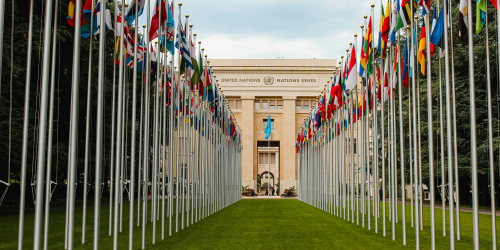The Sustainable Development Goals (SDGs) are a set of 17 ambitious global objectives established by the United Nations to create a better and more sustainable future for everyone. These goals address a wide range of issues, including poverty, inequality, climate change, and economic growth. Financial inclusion, which refers to providing everyone with affordable financial services, especially those who are underserved or marginalized, plays a critical role in achieving these goals. The financial protection gap-where many individuals and businesses lack the financial services required to safeguard against risks-is a significant barrier to progress. Closing this gap through increased financial inclusion is essential for making substantial advancements toward the SDGs.
The SDG Framework and the Role of Financial Inclusion
Financial Inclusion and Poverty Reduction (SDG 1)
One of the core objectives of the SDGs is to eradicate poverty in all its forms. Financial inclusion is a powerful tool in this fight. Access to financial services such as savings accounts, credit, insurance, and payment systems enables individuals to manage their finances more effectively, invest in their future, and protect themselves from economic shocks. For example, microfinance institutions in developing countries have provided small loans to millions of low-income individuals, helping them start businesses and improve their livelihoods. By bringing financial services to the poor, financial inclusion directly contributes to poverty reduction, making it a vital component of SDG 1.
Financial Inclusion and Gender Equality (SDG 5)
Gender equality is another key goal of the SDGs, and financial inclusion is crucial for empowering women economically. Women in many parts of the world face significant barriers to accessing financial services, including cultural norms, lack of financial literacy, and limited ownership of assets. Initiatives that promote financial inclusion for women, such as mobile banking and microfinance programs tailored to their needs, have proven effective in increasing their economic participation and independence. By ensuring that women have equal access to financial resources, financial inclusion supports the achievement of SDG 5.
Financial Inclusion and Reduced Inequalities (SDG 10)
Reducing inequalities within and among countries is central to the SDGs. Financial inclusion helps bridge the wealth gap by providing marginalized and underserved communities with the tools they need to improve their economic standing. For instance, digital financial services have expanded access to banking in remote and rural areas, where traditional banking infrastructure is often lacking. By bringing financial services to these communities, financial inclusion helps reduce economic disparities, contributing to the goals of SDG 10.
Financial Inclusion and Sustainable Cities/Communities (SDG 11)
Sustainable urban development is critical as the world’s population increasingly concentrates in cities. Financial inclusion supports community development by providing access to credit and investment for housing, infrastructure, and small businesses. Innovative financial services, such as community banking and urban microfinance, help ensure that even the poorest urban residents can contribute to and benefit from the growth of their cities. This financial empowerment is essential for building sustainable cities and communities, aligning with SDG 11.
Financial Inclusion and Climate Action (SDG 13)
Climate change poses a significant threat to global development, and financial inclusion can play a role in climate action. Financial services enable individuals and businesses to invest in climate-resilient infrastructure, adopt sustainable practices, and recover from climate-related disasters. Inclusive green finance initiatives, such as climate risk insurance and green bonds, provide the necessary financial tools to support mitigation and adaptation efforts. By integrating financial inclusion into climate strategies, we can help vulnerable populations build resilience and contribute to SDG 13.
Frameworks for Achieving Financial Inclusion and the SDGs
Regulatory and Policy Environments
Creating an enabling regulatory and policy environment is crucial for advancing financial inclusion and, by extension, the SDGs. Governments need to implement policies that promote the development and adoption of financial services, especially for underserved populations. Effective financial inclusion policies can include regulations that support mobile banking, consumer protection laws, and incentives for financial institutions to serve low-income clients. These frameworks ensure that financial inclusion efforts are sustainable and scalable, making a meaningful impact on achieving the SDGs.
Innovative Financial Products and Services
Innovation is key to expanding access to financial services. New technologies, such as mobile banking, blockchain, and artificial intelligence, are revolutionizing the way financial services are delivered. These innovations make it possible to offer tailored financial products that meet the specific needs of underserved segments, such as microloans for small farmers or savings accounts for low-income families. By harnessing technology, we can overcome traditional barriers to financial inclusion and accelerate progress toward the SDGs.
Public-Private Partnerships
Collaboration between governments, businesses, and non-governmental organizations (NGOs) is essential for scaling financial inclusion initiatives. Public-private partnerships (PPPs) can leverage the strengths of each sector to develop and implement effective financial inclusion strategies. For example, a government might provide the regulatory framework, a financial institution the capital, and an NGO the local knowledge and outreach. Successful models of PPPs have demonstrated their ability to expand financial inclusion and drive progress toward the SDGs.
Financial Literacy and Capability
Education is a critical component of financial inclusion. Financial literacy programs empower individuals to understand and use financial services effectively, enabling them to make informed decisions about saving, investing, and managing debt. Building financial capability is especially important in underserved communities, where access to financial education may be limited. By investing in financial literacy, we can ensure that people have the knowledge and skills they need to benefit from financial services and contribute to the SDGs.
Conclusion
Financial inclusion is not just a goal in itself; it is a means to achieve broader development objectives, as outlined in the SDGs. By closing the financial protection gap, we can empower individuals and communities to overcome poverty, reduce inequalities, and build resilience to climate change. The collective effort of governments, businesses, and civil society is essential for advancing financial inclusion and, in turn, the SDGs. As we move forward, it is crucial to prioritize financial inclusion initiatives and ensure that they are integrated into the global development agenda. Together, we can build a more inclusive, sustainable, and resilient future for all.

